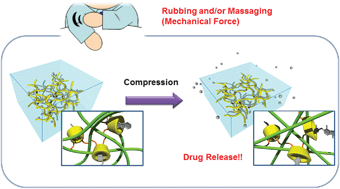β-Cyclodextrin-crosslinked alginate gel for patient-controlled drug delivery systems: regulation of host–guest interactions with mechanical stimuli†
Abstract
Macroscopic mechanical force has attracted much attention as an existing yet novel energy source for modification of molecular interactions and molecular reactivity. Although various molecular level phenomena have been controlled by using macroscopic mechanical forces, control of host–guest inclusion has not been a research target. Here we report a novel controlled release system triggered by a mechanical stimulus. Release of

- This article is part of the themed collection: Rising Stars and Young Nanoarchitects in Materials Science

 Please wait while we load your content...
Please wait while we load your content...